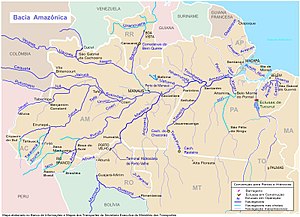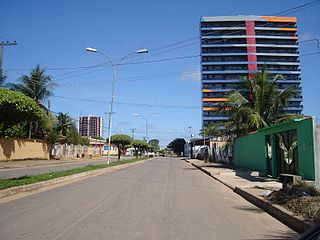| Ji-Paraná River Machado River | |
|---|---|
 | |
| Location | |
| Country | Brazil |
| Physical characteristics | |
| Source | |
| • location | Confluence of Pimenta Bueno and Comemoração, Parecis plateau, Rondônia, Brazil |
| • elevation | 173 m (568 ft) |
| Mouth | Madeira River |
• location | Rondônia, Brazil |
• coordinates | 8°02′55″S62°53′51″W / 8.048599°S 62.897437°W |
• elevation | 43 m (141 ft) |
| Length | 820 km (510 mi) [1] |
| Basin size | 76,127 km2 (29,393 sq mi) [2] |
| Discharge | |
| • location | Confluence of Madeira, Rondônia |
| • average | 2,100 m3/s (74,000 cu ft/s) [2] |
| • minimum | 596 m3/s (21,000 cu ft/s) [2] |
| • maximum | 4,360 m3/s (154,000 cu ft/s) [2] |
| Basin features | |
| Progression | Madeira → Amazon → Atlantic Ocean |
| River system | Amazon |
| Tributaries | |
| • left | Pimenta Bueno, Jaru, Rolim de Moura, Muqui, Urupá, Machadinho, Juruazinho, Preto |
| • right | Comemoração, São João |
The Ji-Paraná River (Machado River), sometimes spelled Jiparaná, is a river in Rondônia state in western Brazil. It is a tributary of the Madeira River in the Amazon Basin. For much of its length it runs roughly parallel with the northeastern state border of Rondônia. The city of Ji-Paraná is divided by the river.
Part of the river's basin is covered by the 221,218 hectares (546,640 acres) Jacundá National Forest, a sustainable use conservation unit. [3] Part of the basin is in the 346,861 hectares (857,110 acres) Jaru Biological Reserve, a fully protected conservation unit created in 1984. [4] The river forms the southern boundary in Rondônia of the Campos Amazônicos National Park, a 961,318 hectares (2,375,470 acres) protected area created in 2006 that holds an unusual enclave of cerrado vegetation in the Amazon rainforest. [5]










